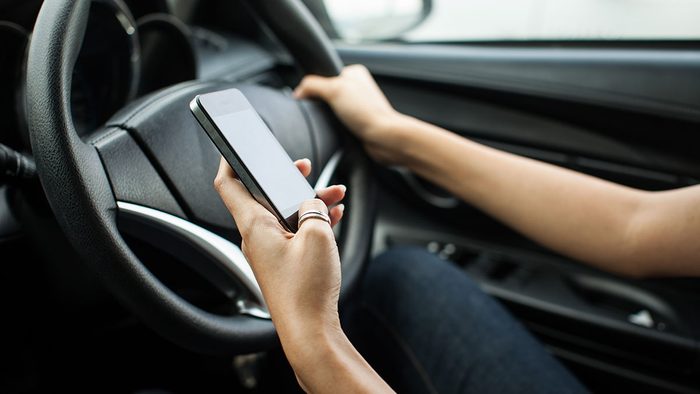
Need a reason to unplug?
One of your most prized possessions is likely one of the dirtiest. Since your smartphone has such close contact with your hands and mouth, and it travels just about everywhere you do, it’s absolutely riddled with germs, including E. coli, staph, and strep. In fact, one study found that cell phones carried 10 times more bacteria than a toilet seat. (Ever wonder why you crave junk food? Find out if bacteria is to blame.)
It’s important to remember to clean frequently, but it’s also a good idea to be aware of these 6 ways your smartphone can actually be harmful to your health.

Exposure to radiation
Your smart-phone exposes you to unnecessary radiation, which some scientists believe may contribute to everything from headaches to cancer. Use these guidelines to manage your exposure:
• Avoid using it when you have a weak-signal or are in a fast-moving vehicle.
• Keep the phone at a distance when downloading large files.
• Use speakerphone or wired
• Put your phone in your purse or bag rather than a pocket.
Check out how smartphones can help you better manage your health concerns.

Text neck
While texting, do you tilt your head forward? Do your shoulders become rounded? If you answered yes to both questions, you could be at risk for “text neck.” According to Dr. Ayla Azad, a chiropractor in Ajax, ON, and Vice-President of the Ontario Chiropractic Association, poor posture while texting is responsible. “Your head is a heavy structure. When you carry its weight forward, your putting a lot of pressure on the base of the neck and top of the shoulders.”
A 2014 Surgical Technology International study confirms Dr. Azad’s clinical experience. Their research found that staring down at your phone could subject your spine to up to 60 pounds of extra weight. The human head weighs on average 10 to 12 pounds. With perfect posture, your spine is designed to carry this weight, but if you bend your head forward, you’ll add extra weight and more stress. The result? Pain. If you’re struggling with back pain, here’s how to find out which type you have.
The cumulative affect of poor posture can create serious health issues. “Most people complain of neck pain, shoulder tightness, upper back pain, and headaches, and if you start to get pressure on your nerves, you can also have numbness and tingling down your arms, and hands,” says Dr. Azad.
How to avoid it: “Be aware of your posture,” says Dr. Azad. Keep your ears aligned with your shoulders, and your shoulders back. “Bring the device up to your eyes instead of bringing your head down,” says Dr. Azad. “Prop your elbows up — if you’ve got armrests on your chairs, use them — and keep your chin up.” Holding your phone in front of your face may look odd, but you’ll avoid painful neck and spine problems.
It’s also important to limit the time using your devices. “The constant repetitive movement, and posture puts a lot of strain on the joints, muscles, ligaments and nerves,” says Dr. Azad.

Driving danger
Drivers aren’t getting the message that texting and using a smartphone is a life threatening practice. According to a 2010 report from the Virginia Tech Transportation Institute, drivers who text while behind the wheel are 23 times more likely to end up in a car crash compared to non-distracted drivers. The frightening statistics don’t end there. “The National Safety Council says that 27 percent — over a quarter — of all car accidents involve cell phones,” says Dr. Stephen Hawrylyshyn, a family physician in Toronto.
How to avoid it: Wait to text or make calls until you’re vehicle is stopped in a parking lot. Keep your phone out of reach to resist the urge to check for messages while driving. For additional help, Dr. Hawrylyshyn suggests the One Tap phone app. “It locks you out of your phone while you’re driving based on your GPS sensor,” he says.
Find out how this app can help those with visual impairment run on their own.

Repetitive strain
If you send lots of texts each day, you could be at risk for repetitive strain injuries of your thumbs, wrists, elbows, and neck. Often texters exhibit poor posture (relieve your back tension with our better posture workout), hunched over with tight forearms, a stance that puts pressure on the joints, muscles and ligaments of the upper body. “The repetitive movement and the amount of time that you’re on these devices is causing these problems,” says Dr. Azad. “We’ve started to see a lot of sprains and strains in kids.”
How to avoid it: “Keep your shoulders back, and your elbows supported, and take breaks. If you’ve been looking down, stop and stretch your neck, look up a few times, move around, and decrease the time spent texting and watching videos,” says Dr. Azad. You can also use the microphone option on your phone to dictate texts.

Restless sleep
A 2008 study by Sweden’s Karolinska Institute, and Wayne State University in the U.S. found that phone use before bed interfered with a good night’s sleep. Their research suggested that the phone’s radiation caused insomnia, and made it more difficult for study participants to enter the first stages of deep sleep.
But radiation isn’t the only problem. According to the American Chemical Society, smartphones emit blue light, which tells the brain it’s time to wake up. If you’re texting underneath the covers, you could be throwing your internal body clock (your circadian rhythm) out of whack leading to bouts of insomnia. Poor slumber has been linked with obesity, depression, and heart disease.
How to avoid it: Remove the temptation and ban your phone from the bedroom. If you must have your smartphone beside your bed, Dr. Hawrylyshyn suggests cutting out screen time at least an hour before bedtime, and using a blue light filter on your phone. Blue light filters decrease your device’s light intensity. “I use one and have noticed an improvement in my sleep quality.” Read up on how social media is ruining your sleep.

Digital eyestrain
According to the American Optometric Association (AOA), extended use of a smartphone can cause eye discomfort such as blurred vision, headaches, eyestrain, dry eyes, and neck and shoulder pain. These symptoms are often classified as digital eyestrain. Improper viewing distance, poor lighting or glare from the device’s screen can spark these eye woes. (Here’s what your eyes can tell about your health.)
How to avoid it: “Try to minimize your use, and take breaks,” says Dr. Hawrylyshyn. The AOA also recommends controlling the brightness and glare of the device’s screen, and adopting proper posture and distances for screen viewing.
